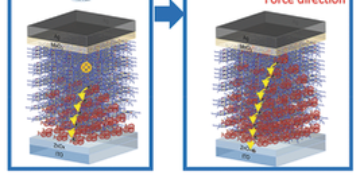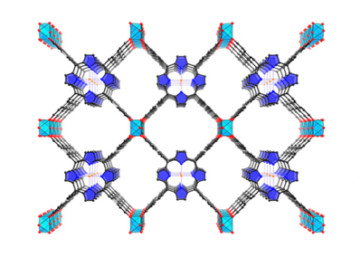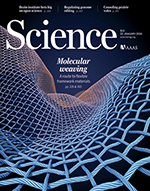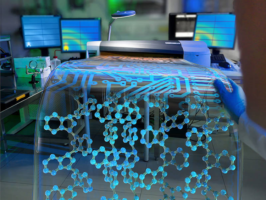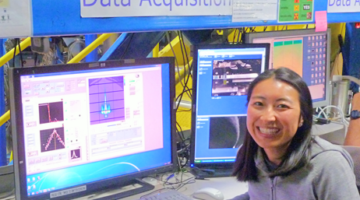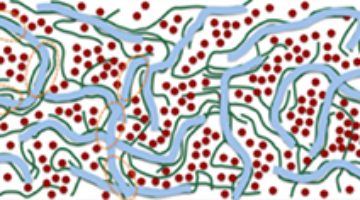Researchers designed DNA sequences that self-assemble into a nanoparticle about 50 nm long, composed of two double-stranded DNA duplexes linked together by a single-stranded DNA filament. The nanoparticle resembles nunchaku—a traditional weapon of several martial arts—but 30 million times smaller. Read more »
Superlattices Patterned by Polymers
Scientists have shown that self-assembled superlattices, made up of nanoparticles with polymer chains grafted onto their surfaces (“hairy nanoparticles,” or polymer “brushes”), can be tailored to exhibit desired characteristics for applications ranging from nano- to biotechnology. Read more »
On the Way to Unlimited Energy
With the help of four different ALS beamlines, scientists were able to understand and improve the morphology of the main device structure in organic photovoltaic cells. Read more »![]()
Porous-Framework Electrocatalysts Are Key to Carbon Dioxide Conversion
Researchers have made significant headway in the quest to convert CO2 into valuable chemical products such as fuels, pharmaceuticals, and plastics. Recent work at the ALS has shown MOFs and COFs as a valuable new class of CO2 reduction catalysts. Read more »![]()
![]()
Weaving of organic threads into a crystalline covalent organic framework
Threads made from organic molecules linked by strong covalent bonds were used to weave a 3D covalent organic framework with unusual dynamical and mechanical properties. This molecular weaving method will enable the production of materials with increased precision and functionality. Read more »
Following the Morphology Formation In Situ in Printed Active Layers for Organic Solar Cells
Time-resolved scattering measurements reveal the complete solidification process inside the photoactive layer of an organic solar cell. With an industrial slot-die coater integrated into the beamline, aggregation and crystallization processes can be tracked to reveal the structure-function relationships in the final thin film. Read more »
Custom Organic Electronics Out of the Printer
Using in situ x-ray characterization and a custom-made slot-die coater at Beamline 7.3.3, the cross-linking of polymer molecules in the active layer of an organic solar cell during the printing process could be observed.
Read more »
Elaine Chan Fosters ALS/Molecular Foundry Collaboration
In an ongoing effort to build closer working relationships between Berkeley Lab’s light source and nanoscale science research center, Elaine Chan has recently been appointed by the ALS and the Molecular Foundry to a new role as joint ALS/Foundry project scientist. Chan’s mission will be to foster collaborations between the two facility’s users and to communicate a wider understanding about how the two research centers are mutually scientifically beneficial. Read more »
In Situ X-Ray Scattering Helps Optimize Printed Solar Cells
Printable plastic solar cells are a potential source of inexpensive renewable energy, but the transition from lab to factory results in decreased efficiency. Now, for the first time, a miniature solar-cell printer installed in a beamline allows researchers to use x-ray diffraction and scattering to figure out why. Read more »![]()
![]()
Student UEC Member Goes Above and Beyond
As a student representative to the ALS Users Executive Committee (UEC) for the past two years, Mahati Chintapalli has gained a better understanding of how the ALS functions as an organization, while the UEC has gained a devoted and outgoing member. She’s currently a PhD student in Materials Science and has been conducting research at the ALS since 2011. Read more »
- « Previous Page
- 1
- …
- 4
- 5
- 6
- 7
- Next Page »


